THE DAGUERROTYPE
Introduced in 1839 by a Frenchman, L. J. M. Daguerre, the Daguerreotype was a photographic process produced on a silver-coated copper plate that has a reflective mirror-like surface. The majority measure 2¼ by 3¾ inches, although some are larger or smaller. They were mounted in fancy box-like cases and frames and some were mounted in jewelry. Such pictures had to be preserved behind glass because they were extremely delicate and would disappear if touched or tarnish if exposed to air. They were popular from 1839 to the late 1850’s.1

A daguerreotype studio was often situated at the very top of a building, which had a glass roof to let in as much light as possible. The subject either sat on a posing chair or clamped to a stand, and were placed on a raised platform, which could be rotated to face the light.
John Carl Frederik Polycarpus von Schneidau—1812-1859
Chicago Tribune, December 12, 1897
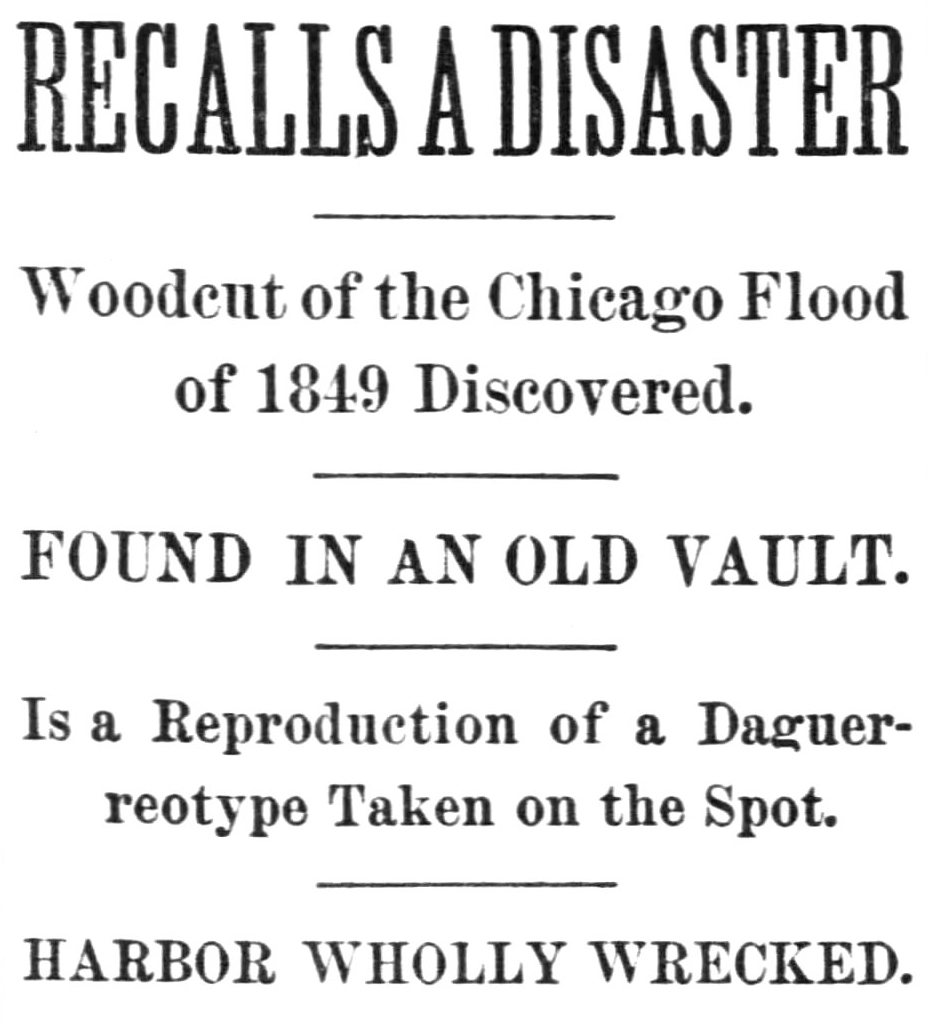
One of Chicago’s earliest calamities, the disastrous flood in the Chicago River on March 12, 1849, Which carried away every bridge and half the shipping in the river, doing a damage of over $100,000, is recalled by the discovery in an old vault of a woodcut made from a daguerreotype taken on the day of the flood by P. von Schneidau, Chicago’s first photographer.
The picture shows a scene of disaster at a point near where the Rush street bridge now stands, and presents a view of jumbled vessels, bridges, ice, and logs—all jammed together in one mass, the result of water and ice. The flood began its work of destruction south of Madison street and swept north in the South Branch to the main stream, and thence toward the lake to the old military garrison, where it was partly checked by its own work of wedging tightly together every object that joined in the whirling mass.
The picture really portrays only a small part of the damage done by the flood. Out in the lake dozens of craft, from canal boats to steam vessels, which were swept past the garrison before the jam occurred, sank or turned keel upward from the effects of the crushing received in the passage with the swift current.
For a mile out in the lake the surface was dotted with what was even then Chicago’s pride, its shipping. Upon a mudbank at the entrance to the river lay the Randolph street bridge, side by side with sailing craft in positions just as undignified, while floating hither and thither out in the lake, as if undecided as to how to take its new experience, was the structure which a few hours before had spanned the river at Clark street. In every direction from the mouth of the river were steam and sail vessels, canal boats, barges, and other craft, some still carrying human beings and others totally deserted, floated in the open lake. Occasionally a hole in the hull of a vessel would take in its last gulp of Lake Michigan’s waters, and then one of the unlucky fleet would disappear from sight. Some succeeded in anchoring and all that did not sink from sight were eventually brought safely in by the more fortunate vehicles.
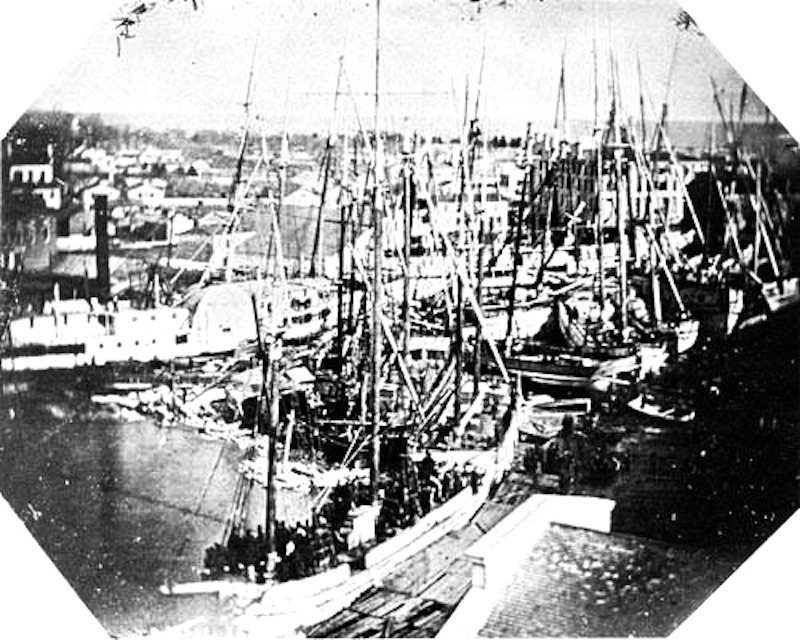
Daguerreotype of the Great Flood.
P. von Schneidau
March 12, 1849
No Loss of Life.
That with the record of damage done by the flood there was no occasion for adding a loss of was considered a wonder.
Twenty-five vessels lost, sixty damaged more or less, four bridges swept away, and lines of docks torn from the banks. $100,000 damage done to shipping, $10,000 to bridges, and $10,000 to docks was the record of the rush of water and ice which brought consternation to Chicago’s early citizens. Shipping was demoralized for a time, plans for municipal improvements were revised to allow funds to be used in repairing the damage done, and popular sentiment called for tunnels under the river instead of bridges that a flood could sweep away. The movement for tunnels resulted soon after in the construction of the Washington street passage under the river.
While the work of destruction was going on in the river its banks were lined with citizens watching the fearful work work of the rapid current. At the garrison, where the jam occurred, the banks of the river were lined with people watching the restless mass of ice, vessels bridges, and parts of docks, and listening to the crunching, the snapping of spars and cables, and the shouts of men endeavoring to save something from the general wreck.
The trouble began at 9 a.m. on Monday, March 12, 1849, when a dam of ice which had formed in the South Branch gave way. The hawsers of the nearest vessels immediately snapped, giving the whirl its first victims and aid to other destruction. The first obstacle—Madison street bridge—soon gave way and joined in the rush, together with every craft between Madison and Randolph streets. The bridge at the latter point suffered similarly, then Wells and Clark street bridges and everything between them, a good part of the whole mass piling itself high where the Rush street bridge now stands.

Chicago City Directory
1855
Chicago Tribune, June 10, 1897

It was an exile of Sweden who brought the first daguerreotype camera to the West. He died without seeing the art develop much beyond his primitive knowledge of taking, and the following notice, which appeared in The Tribune of Dec. 28, 1859 was all that was written at the time of his death:
- DIED—In this city, on the 27th last, at noon, POLYCARPIS VON SCHNEIDAU, Vice-Consul of Sweden and Norway, in the 48th year of his age. Funeral this afternoon at 2:30 o’clock from the residence of N. E. Peterson, 252 North La Salle street. His friends are invited to attend.
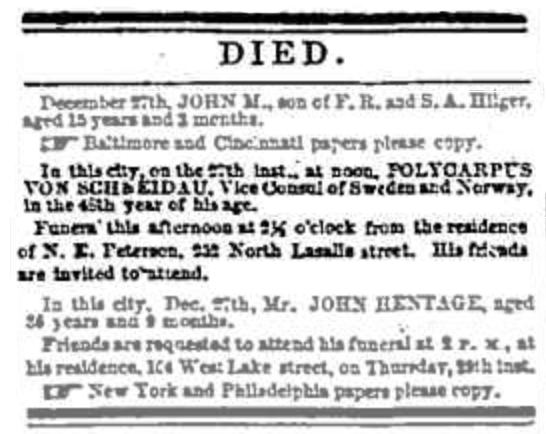
The full name of this pioneer picture-taker was John Carl Frederik Polycarpus von Schneidau. He came to America in the early ’40’s, and when Daguerre’s wonderful discovery, by which images from the lens of a camera couid be fixed upon metallic plates, became known, Von Schneidau was one of the first to be attracted by the new process. He went East, studied the art with Daguerre, the chief pioneer of modern picture taking, returned to Chicago a little later prepared to operate a camera himself. He opened a gallery at Lake and Dearborn streets, the first of its kind in the city. The process of daguerreotyping was a novelty, and Von Schneidau’s camera was something much wondered at. His studio was the center of interest and hundreds of persons called there out of mere curiosity.
Von Schneidau became proficient in the use of the new process and received a gold medal at the Mechanics’ Institute for his exhibits. Some of the daguerreotypes taken by him in this primitive stage of the art are still in existence and bear evidence of the skill of the artist. Von Schneldau was born in Stockholm, Sweden, Feb. 20, 1812. He was a son of John Henric and Baroness Antoinette Cronhjilm, the last male descendant of an illustrious house—one of the few remaining representatives of the Rix nobility. He entered early into military life, attending the naval academy at Stockholm. In 1834, at the age of 22, Von Sehneidau was made a sergeant in the navy by special decree of King Bernadotte. He was soon promoted to a Lieutenaney in the royal navy, and three years later was appointed general staff officer and aid to the King.
Von Schneldau loved a Jewish girl—Carolina Jacobson. She was beautiful and belonged to an influential family in Stockholm, but by the laws of Sweden a Protestant was forbidden to marry with one of the Jewish falth. Despite this Von Schneidau married the object of his affection in 1842, but was forced to resign his military position and with his wife flee from the country. He came to America, his destination being Pine Lake, Wis., a small settlement which had been established a few years previous by a party of Swedes had emigrated here.
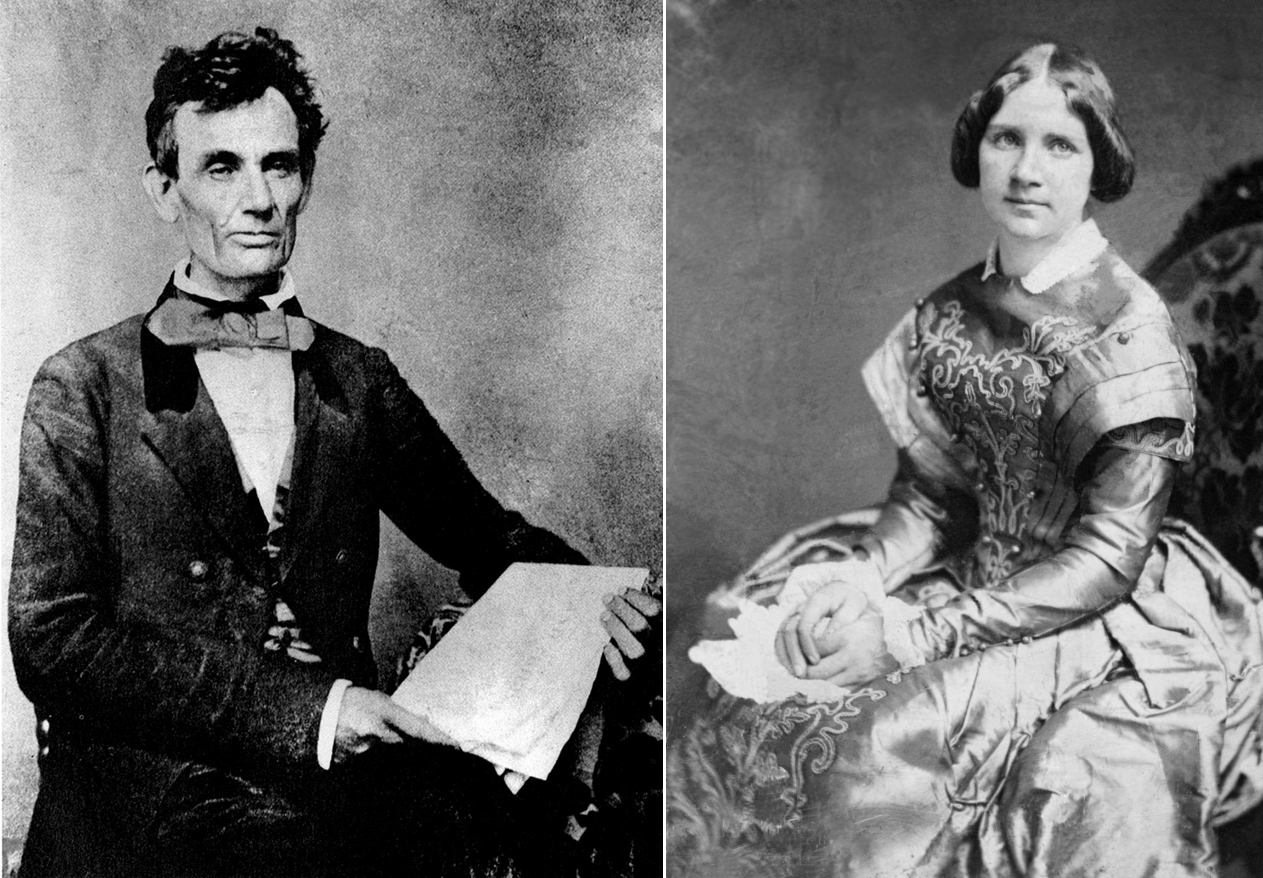
LEFT: Abraham Lincoln in Chicago, October 27, 1854
RIGHT: Jenny Lind, September 14, 1850
Von Schnieldau soon found, however, that he was not for an agricultural or commercial life. He was a man of polished and courtly manners, and farming was a long way from satisfying his desires. In 1844, at the instance of friends, he moved to Chicago. Here he spent a year in teaching French, dancing, fencing. and gymnastics. During thle next two years he explored the district around Lake Superior With the hopes of discovering mines.
In 1847 Daguerre’s discovery became known to Von Schneidau. The taking of what was then termed as “sun paintings” interested him greatly, and he went to New York City to investigate the process and to with his intimate friend and fellow-countryman, John Ericsson. He also consulted scientific men in Harvard and Yale Colleges, He spent considerable time with Daguerre, studying the process, but to what extent is not known. He returned to Chicago with the necessary outfit for taking daguerreotype, and thus became the pioneer of this city in art work.
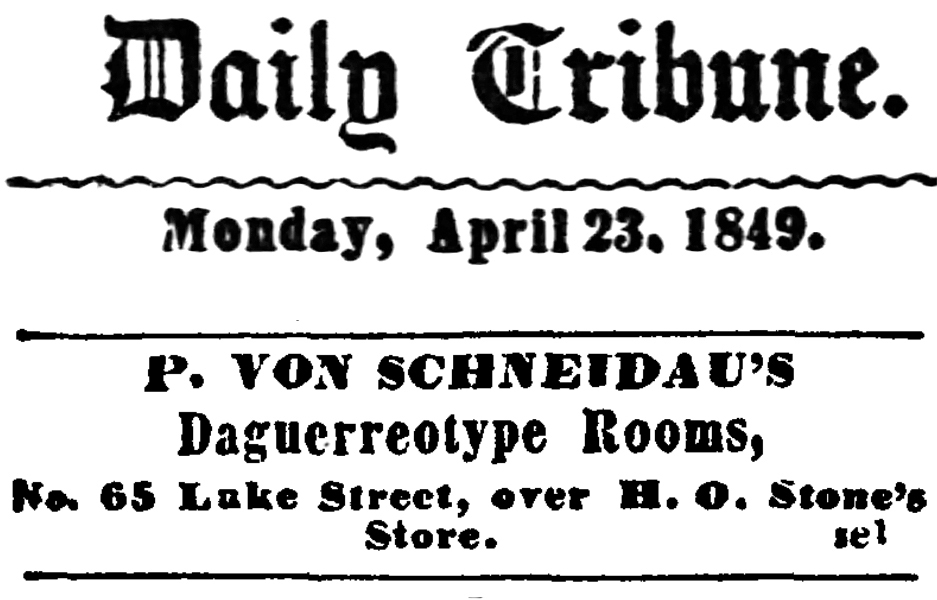
Von Schneidau had been for many years an intimate friend of King Oscar I., and in 1852 he was appointed Vice-Consul for Sweden and Norway. Two years later Denmark was also added. As a recognition of the services which he rendered the Swedes and Norwegians who came under his jurisdiction in the West during this time King Oscar sent him his portrait and a gold medal, both of which Von Schneidau held ever afterwards as valuable treasures. In 1856 ill-health, caused, it was thought, by the chemicals used in his gallery, compelled Von Schneidau to leave Chicago and try the baths of Elgersburg, Germany. He also went to Berlin, and was under the care of specialists, but found no relief. While in Berlin he met and became the friend of Von Humboldt, and also became acquainted with several other German scientists. He returned to America in 1858, a helpless paralytic. and died in this city Dec. 27 of the following year.
William B. Ogden and B. H. Sheldon were for years intimate friends of Von Schneidau and his wife. After his death, at the request of the Swedish Government, they became the guardians of Von Schneidau’s only child, Pauline. She was taken to Mr. Ogden’s home in Boscobel. N. Y., on the Harlem River, where she was educated. She was married to Eugene M. Jerome of New York on July 1. 1887, and is now living with her husband in Williamstown, Mass.
November 2008
Picturing Lincoln
By Vernon Burton
Dr. Burton is a professor emeritus of history, sociology, and African American studies at U of I and is the author of Age of Lincoln.
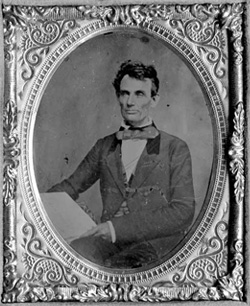
This ambrotype comes from the lost daguerreotype of a photograph of Lincoln in Chicago, on October 27, 1854. The paper he’s holding had been altered at one point.
In 2007, the Abraham Lincoln Presidential Library and Museum in Springfield, Ill., acquired a copy of a priceless 1858 ambrotype of a lost daguerreotype from an 1854 photograph of Lincoln. The picture, the second oldest image of Lincoln known to exist, is valued both for its rarity and for the insight it offers into how we picture Lincoln.
The 1854 photo came about when George Schneider, who published the German anti-slavery newspaper, Illinois Staat-Zeitung, invited Lincoln to Chicago to speak in response to the passage of Illinois Senator Stephen Douglas’s Kansas-Nebraska Act. While Lincoln was in Chicago, Schneider persuaded him to stop at a photography shop next door to Schneider’s newspaper, where photographer Johan Carl Frederic Polycarpus von Schneidau took his picture on October 27, 1854. In this 1854 daguerreotype, Lincoln held the stridently anti-slavery German-language newspaper in his hand. The original daguerreotype was subsequently lost, probably in the Chicago fire of 1871.
The picture resurfaced in 1858, but this time as an ambrotype, as interest in Lincoln was re-awakened by his two trips to Chicago—once to reply to Douglas’s opening speech in the 1858 senatorial campaign, and the other to consult with Republican leaders about challenging Douglas to formal debates. The ambrotype belonged to Samuel Alschuler, a photographer from, of all places, Urbana, Ill., who had recently moved to Chicago and purchased Polycarpus von Schneidau’s photography shop. Alschuler was a Lincoln photographer in his own right, having photographed the future president a few months earlier during Lincoln’s visit to Champaign County. His unusual image captured Lincoln trying to suppress a laugh because of the undersized jacket he had borrowed for the impromptu photograph. Alschuler had sold the original to a local circuit court clerk in Urbana (the photo now resides in the University of Illinois Library), and thus turned to Polycarpus von Schneidau’s image and reissued it in response to the renewed interest in Lincoln.
There was a subtle but major change in the otherwise identical pictures. Whereas in 1854 Polycarpus von Schneidau had posed Lincoln with an issue of the Illinois Staat-Zeitung, the 1858 ambrotype had Lincoln holding the Chicago Press and Tribune, the forerunner of the Chicago Tribune. Charles Ray and Joseph Medill had bought the paper in 1855. Medill, who was the editor of Chicago Press and Tribune, wanted to promote his paper and his moderate Republican cause by showing the popular Republican Abraham Lincoln reading his paper. Moreover, it would help Lincoln’s chances if he held the moderate Chicago Press and Tribune rather than the radical anti-slavery German-language newspaper. Thus, Joseph Medill, who would be one of Lincoln’s major supporters at the Republican nominating convention held in Chicago in 1860, directed Alschuler to have an artist artfully superimpose the masthead of his newspaper over the copy of the Staat-Zeitung. Medill and the Tribune supported Lincoln throughout the war and for re-election. Medill would become the reform mayor of Chicago in 1871, running on the Fireproof Party.
Over his years in office Lincoln learned to use photography to build support for himself, particularly the “card-portraits” that had became very popular by the time of the Civil War. Lincoln recognized that people felt closer to him on the issues when they had a picture of him.
The superimposition of one newspaper over another in the 1858 ambrotype, however, is a metaphor for all studies of Lincoln. Historians, as well as the general public, use Lincoln to promulgate their own personal views. Moreover, as the altered image of the 1854 photograph illustrates, historians must be wary of trusting even visual evidence; things are not always as they seem.
Alexander Hesler—1823-1895
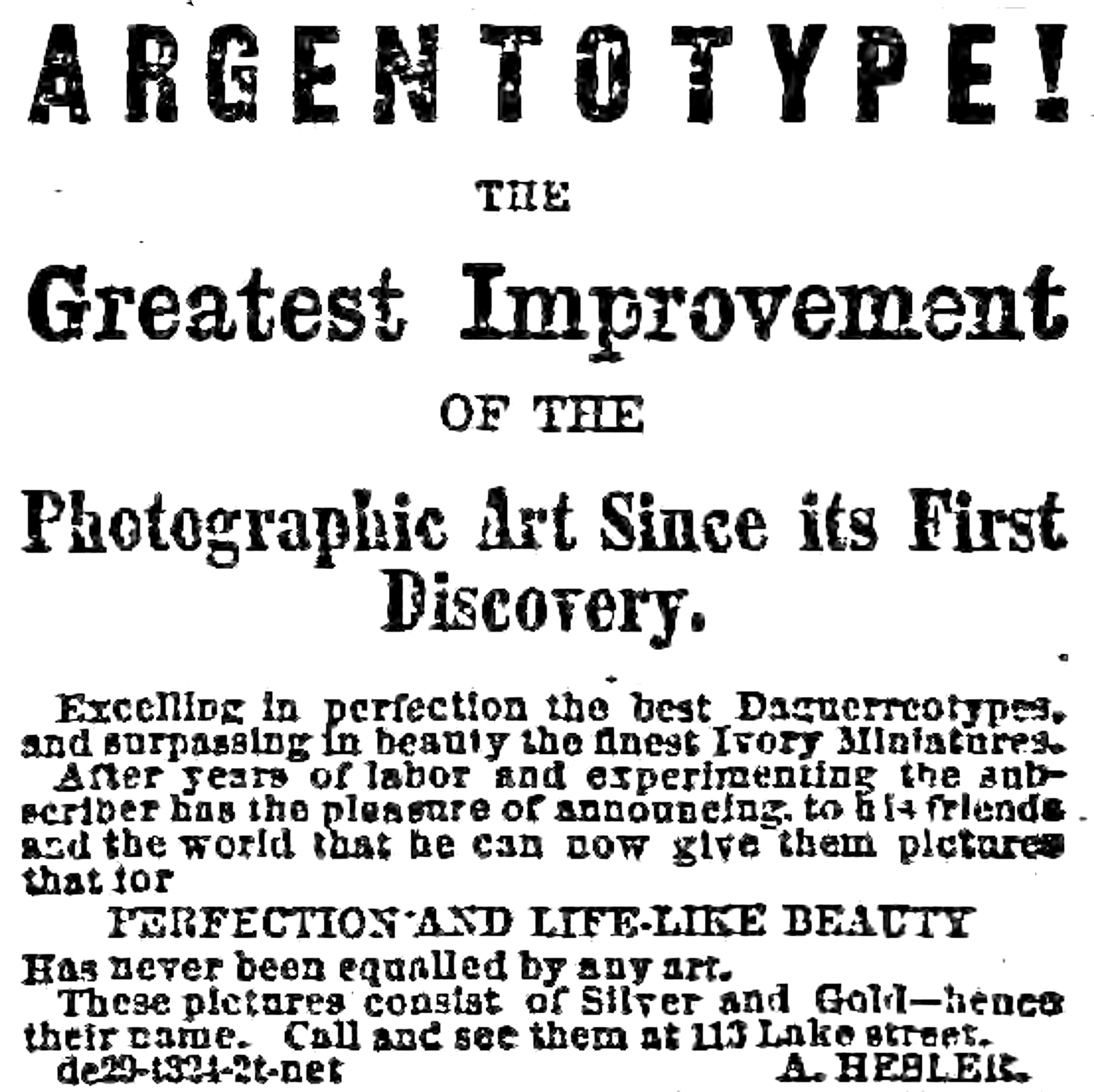
Chicago Tribune, January 16, 1864
A NEW THING IN ART.—The new Argentotype is to other pictures as silver and gold to other metals, and to Alexander Hesler belongs the credit of introducing them in this city. He has made the daguerreotype truly an art, and wrought at its development with untiring diligence. The Argentotype stands at the crown of his labors and discoveries. It is in appearance a miniature painting, with a brilliancy and tone that coupled with the accuracy insured by the camera, produce one of the finest effects we have yet seen realized and one destined to become most popular with the public. In an earlier stage of the discovery we referred to this new class of pictures, but since then the process has been made complete, and the results are what we have stated. Mr. Hesler’s name will be connected with the daguerreotype art for all to come.
Chicago Tribune, July 6, 1895
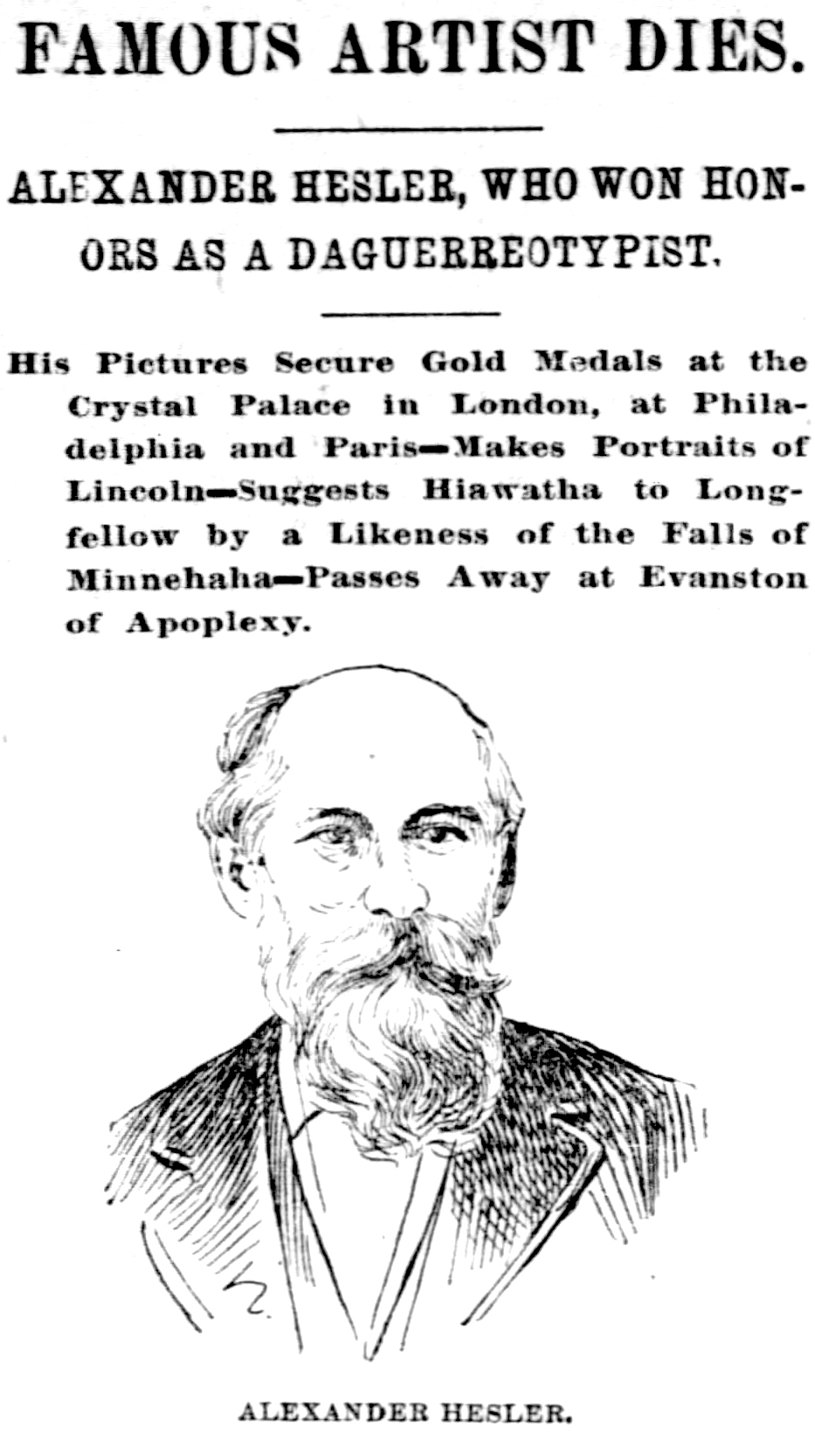
Alexander Hesler, the pioneer photographer of Chicago, and for many years the most famous daguerreotypist in the United States, died at his home in Evanston yesterday morning at 8 o’clock. Mr. Hesler had not been ill twenty-four hours. While taking a flashlight picture in the afternoon of July 4 for one of his neighbors he was stricken with apoplexy. He became unconscious and was removed to his home, No. 216 Lake street, where he died the next morning without regaining consciousness. The funeral exercises will be held at the house Sunday at 4 p.m. and the internment will take place at Racine, Wis., the next day.
Mr. Hesler’s photographs made him famous. Among them are two of Abraham Lincoln, the first ever taken of the martyr President. The one of Minnehaha Falls. taken in 1856, is said to have inspired Longfellow to produce “Hiawatha.” Mr. Hesler has won many medals from international exhibitions. He was honored thus at the Crystal Palace of Londin, the Centennial Exposition, and the Paris Exposition.
Mr. Hesler was born of English parents in July, 1823, at Sorell, near Montreal, Canada. He came West when a young man and settled at Racine, Wis. He was in the hardware trade for a while, but in 1847 he learned daguerreotyping. He followed this profession for two years in Racine, and removed to Galena. While in the latter city he prepared an exhibit of daguerreotypes for the Crystal Palace Exhibition at London in 1851, on which he received several medals, one of which was a first prize. He came to Chicago in 1853, where he became famous. From 1853 to 1858 he occupied rooms in the old Metropolitan Block, and from 1858 till the building was burned in the great fire he occupied quarters at No. 113 Lake street.
After photography had superseded daguerreotyping he became well known also in that line. His “bird’s eye view of Chicago” taken the year before the fire2 from the top of the Court House, has become famous and is now the most correct likeness of what the city was in those days.
In February, 1857, Mr. Hesler took a daguerreotype picture of Mr. Lincoln. It was duriungb the time of Lincoln and Douglas were stumping the State together, and Lincoln came over to his office one day from the Court House and said “the boys wanted him to have a picture taken.” Mr. Hesler made a bust picture which was nearly a profile of the right side. The picture is similar to one taken four years later, with the exception that Lincoln’s hair in the first one was long and appeared disheveled, Mr. Hesler suggested at the time that he comb it, but Lincoln said no, the boys would not know if he did. Mr. Lincoln was so well satisfied with this picture that after his first nomination, when there was a call throughout the country for his likeness, he sent to Chicago for Mr. Hesler, who went to Springfield in June, 1860, and made two more pictures of the great statesman. One of these became the most famous likeness of Lincoln, taken while his face was yet unbearded. It was almost a profile, showing the right side of his face.
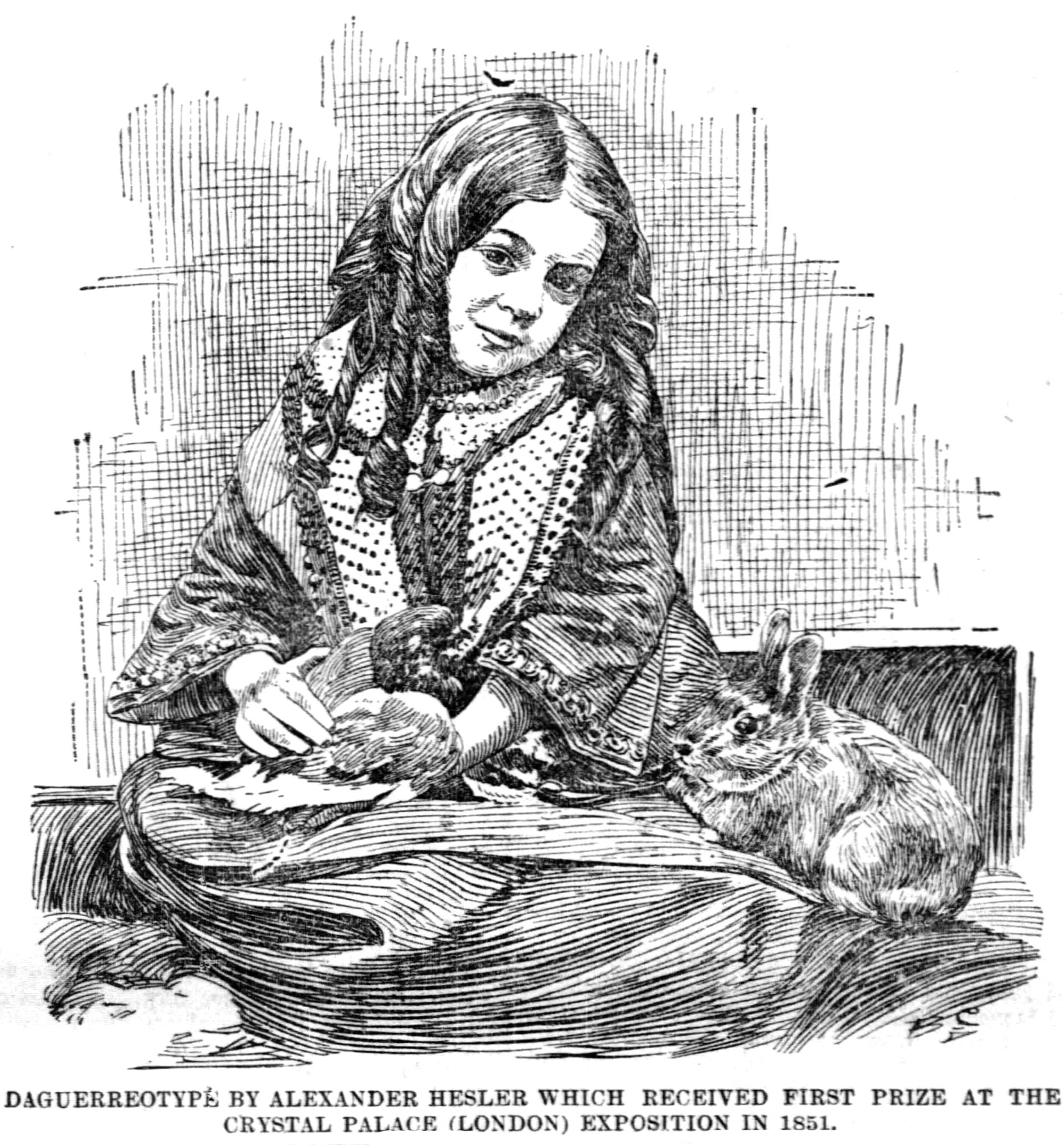
Makes Pictures of Lincoln.
The other picture taken at this time was almost a front view. The uneven outline of his face, his high cheek bones, show up distinctly against a dark background in this portrait. His coat was plain black and he wore a black bow tie, with a white collar turned loosely over it. These two pictures in miniature were ordered by the hundreds of thousands and sent all over the country.
In 1855, Mr. Hesler was in Minnesota and took what was probably the first picture of the Falls of Minnehaha. It was in November and the trees and brush in the vicinity were glistening with frost from the spray and the adjacent rocks were covered with snow. A copy of this picture was given to Henry W. Longfellow. A year later Mr. Hesler received a copy of “Hiawatha,” with the compliments of the author and an autograph letter from him saying that was Mr. Hesler’s picture of the romantic falls that suggested to him the poem. When he wrote the poem Mr. Longfellow had never seen the falls, and it was not for several years later that he did see them.
Mr. Hesler was a lover of flowers and of children. He kept many plants in his house during the winter from which to cut flowers to send to his neighbors.
Several years ago Mr. Hesler took a picture of the little daughter of Dr. Jewell. The child was laughing, and the likeness was so lifelike and beautiful that it was copied and recopied in this country and Europe. His book called “Picturesque Evanston” is a collection of artistic views of his own home town.
Mr. Hesler was married in 1849 to Helen E. Dorchester, daughter of Capt. J. Dorchester of Racine. He survived her scarcely a year. He leaves four children: Dr. Fred Hesler, a surgeon in the United States navy, on the Philadelphia, Arthur J. Hesler, a traveling salesman for Reid, Murdoch & Co., Harold R. Hesler of Evanston, and one daughter, Miss Helen.
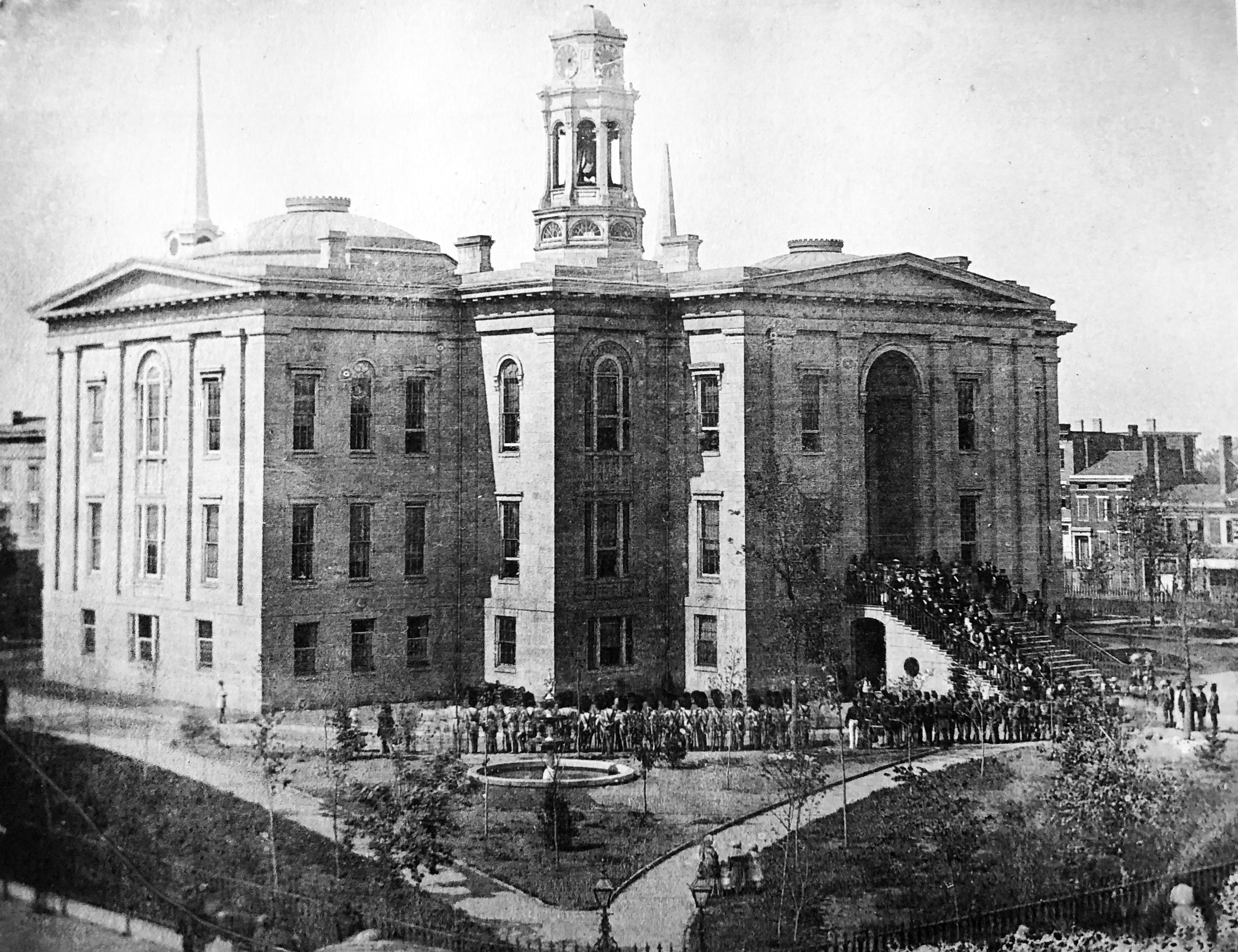
This Daguerreotype was taken on July 4, 1855, by Alexander Hesler. Montgomery and Emmett Guards being addressed by John Wentworth. Note that the third floor and dome were not added yet (1858). The basement was above ground.

The Lincoln Portraits by Alexander Hesler
All daguerreotypes were were taken on June 3, 1860, except the first one on the far left, which was taken on February 28, 1857.
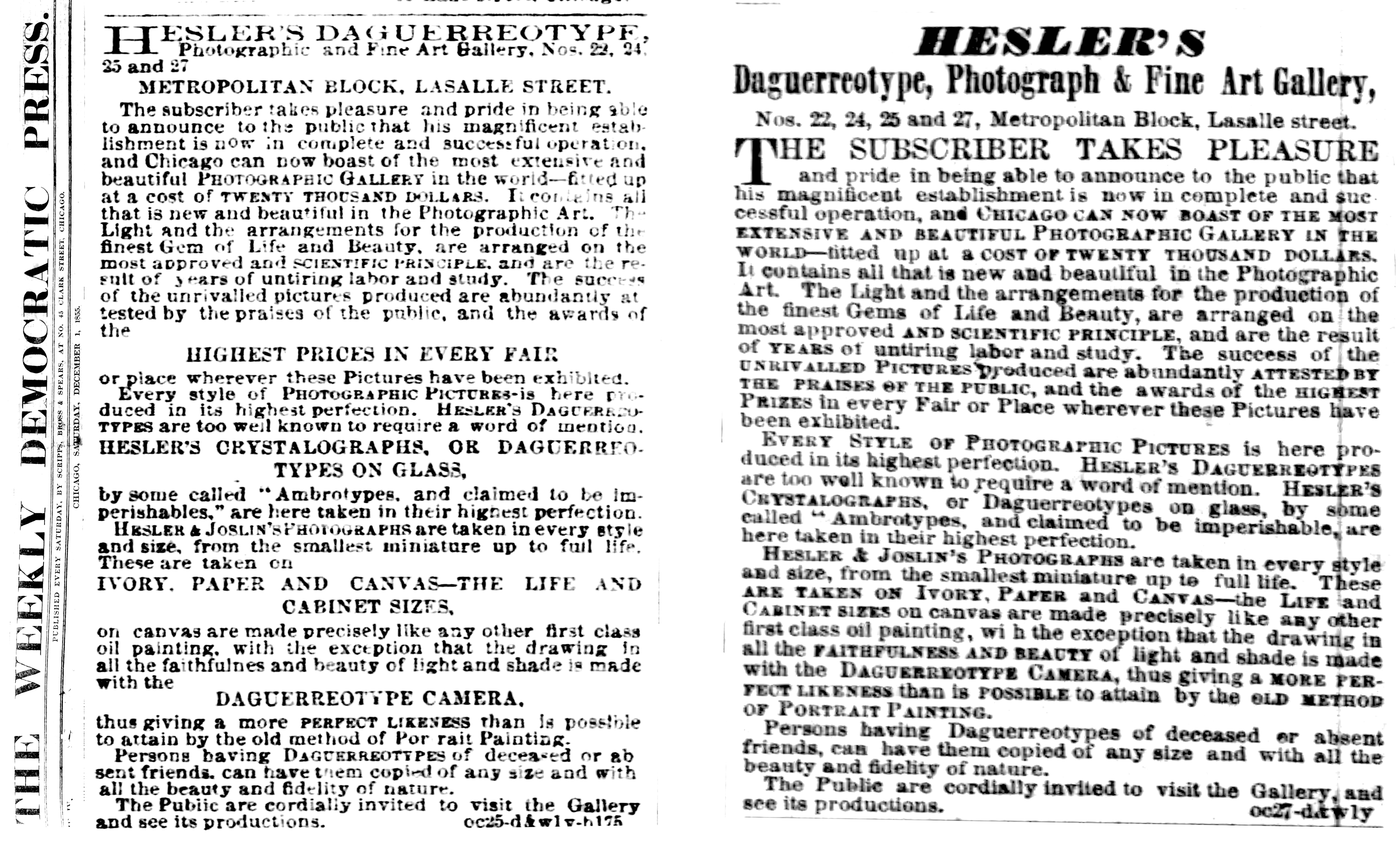
Weekly Democrat, December 1, 1855
Chicago Tribune, April 29, 1856
The Photographic Times, September, 1895

Alexander Hesler, the veteran photographer, and one of the finest daguerreotypists whoever lived, died at Evanston, July 4th last. Mr. Hesler was stricken with what appeared to be apoplexy, and he did not regain consciousness. Mr.Hesler was over seventy year sold, and his age made it appear doubtful whether he would recover; dissolution came to the old gentleman without pain or consciousness.
Hesler was probably the oldest photographer in Chicago. He had a studio here many years before the great fire, and suffered with many other citizens in that calamity. Soon after the fire here moved his business to Evanston, where he remained until 1880, when he returned to Chicago. For a long time his studio was located at Randolph and State Streets. At the time of his death it was at 147-153 Fifth Avenue. The veteran photographer’s “Picturesque Evanston,” a book of views of every point of interest in that little city, gained a wide circulation and made the artist many friends.
Was a Great Daguerrotypist.
General Arthur Ducat said to-day:
- Alexander Hesler was the greatest daguerreotypist America ever produced—perhaps the best the world ever knew. He flourished in the height of the business, traveled all over the world, received medals and prizes in England and France—in fact, almost everywhere. Among his triumphs was the first medal at the world’s fair, Crystal Palace, London, in 1851. No deeper student of posing and nature ever directed a lens at an object. Hecould produce daguerreotypes that might almost be said to talk. He lived in Galena in the forties, and was acquainted with Russell Jones, Judge Van Higgins, the Campbells, and other prominent families. Alexander was born in Canada, and was of French extraction. I do not remember just when he went to Galena. He came to Chicago in the fifties, and for some time stood at the head of the daguerreotype business. Strangely enough, while he was the greatest daguerreotypist—a true born artist—he seemed to become apathetic when the art of photography invaded his field, and did not make such a success at the latter as he did upon the silver plates. He was a generous soul, good and kind, and of an extremely genial nature.
Perhaps no other sportsman who went into the new western country in those early days, enduring all manner of hardship and exposure, was as great a wild fowl shot as Alexander. He and his companions, the late Charles Winston and Sydney Kent’s brother, made a trio of hunters who were not excelled in their time. The deceased leaves three sons and a daughter. One son is a surgeon in the United States Navy, another is with Reid, Murdoch & Co., and the third is attending college. In brief, I think that is a fair sketch of my old friend Mr. Hesler.
Hesler and “Hiawatha.”
G. A. Douglass, the photograph-supply man, who had known Alexander Hesler for years, was surprised to learn that the photographer had passed away.
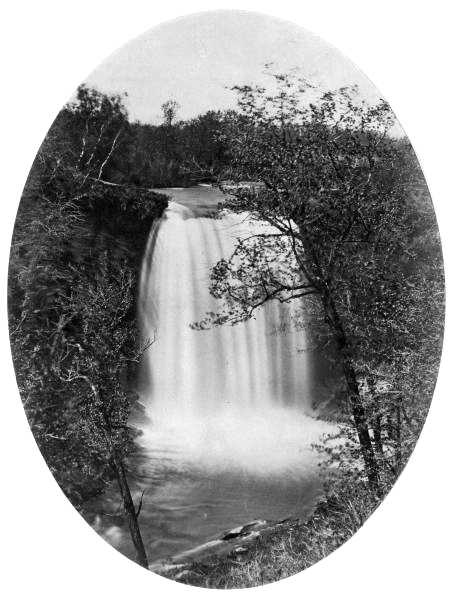
“The old gentleman was a truly great artist; in fact the leading daguerreotypist in the country,” remarked Mr.Douglass. “He came to Chicago from Galena and did the best work in the West. Of late he had been doing work for Milander Bros., and it pleased him greatly to think that so many photographers were assisting in reviving an era of daguerreotyping, for one of these pictures, well made, he considered a grand work of art. It has been made the subject of much comment among artists and poets that it was Mr. Hesler who was principally responsible for the inspiration which induced Henry W. Longfellow to write ‘Hiawatha.’ The incident became known at a dinner in this city attended by old-time photographers, at which anecdotes were discussed as well as choice morsels and cigars.
It seems that Mr. Hesler, armed with his picture-taking paraphernalia, wandered into the Northwest in search of nature’s beautiful retreats. This was in 1851, and in August of that year he tramped over the present site of Minneapolis. There was no sign of a city at that time. Coming upon the falls of Minnehaha, he took several views of the natural poem. While arranging his pictures he was accosted by a man who said his name was George Sumner. The latter purchased two pictures of Minnehaha to take to his home in the East, remarking that he would retain one and give the other to his brother Charles.
“The incident had nearly been forgotten by Mr. Hesler when it was revived in a startling manner. He received an elegantly bound volume of a work by Long fellow, and the principal poem was ‘Hiawatha.’ On the flyleaf was the poet’s signature and the legend ‘With the Author’s Compliments.’ Hesler was puzzled to account for the poet’s solicitude, and almost a year after the receipt of the book he met George Sumner, who explained the mystery.”
Longfellow Saw the Picture.
“It seems that the daguerreotype had got into Long fellow’s possession and, taking it with him into the woods, he got his inspiration, as he said, from the pretty view, and wrote ‘Hiawatha.’ Mr. Sumner said that it was a good thing for the poet that it was the counterfeit of Minnehaha Falls, not the real article, that the poet gazed upon for his inspiration, otherwise there would have been no ‘Hiawatha’ written. Hesler must have been a great artist to move a poet so with his handiwork.”—Chicago Evening Post.
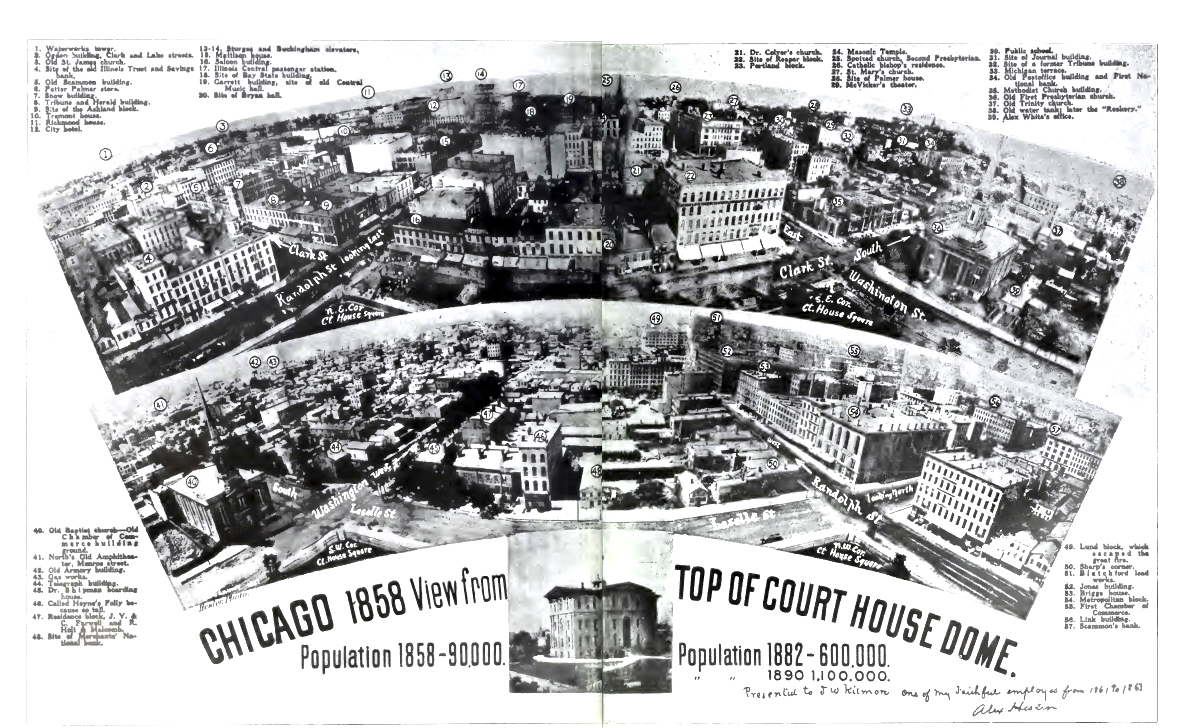
Alexander Hesler’s Panorama of Chicago
August 10, 1858
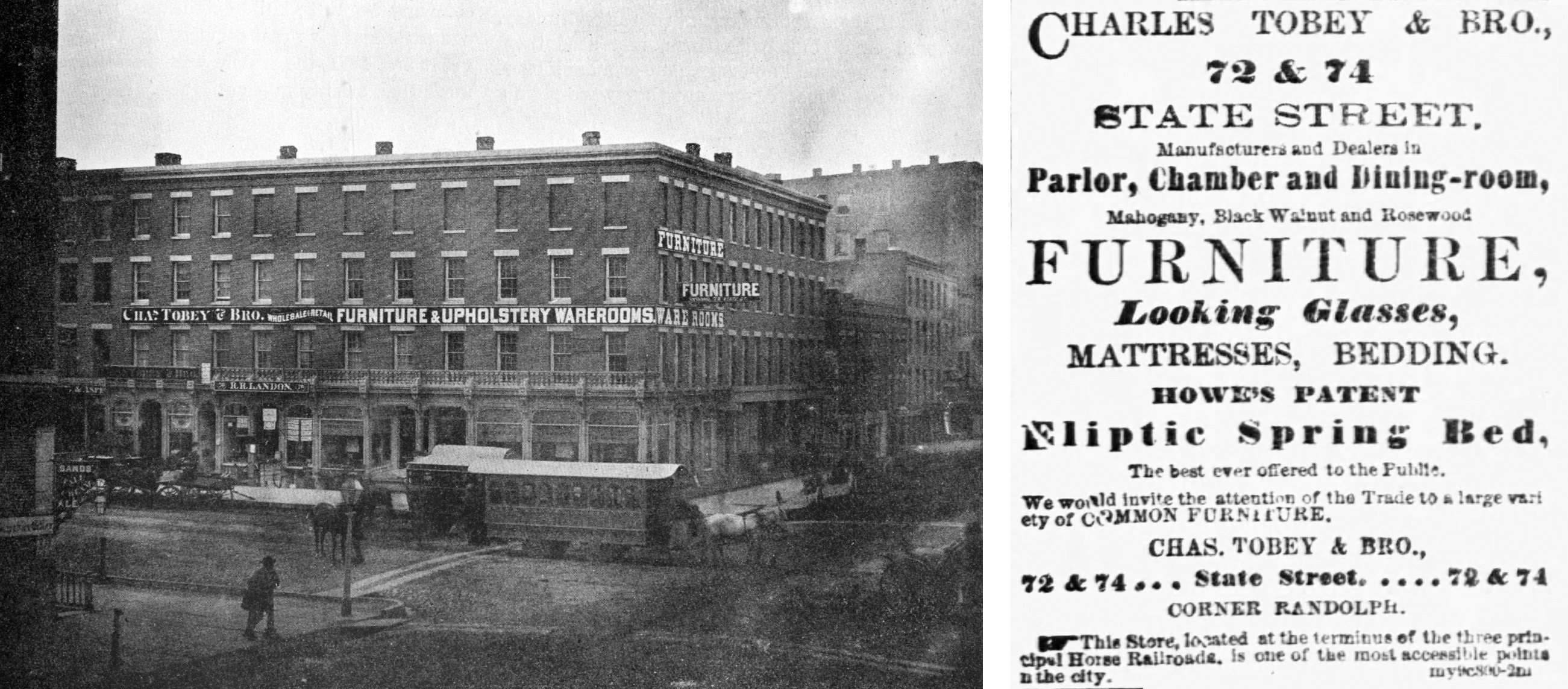
The southwest corner of State and Randolph Streets in 1857. Taken from a daguerreotype by an unidentified daguerrotypist. Charles Tobey and Brother were here at 72 State Street from 1857 to 1862.
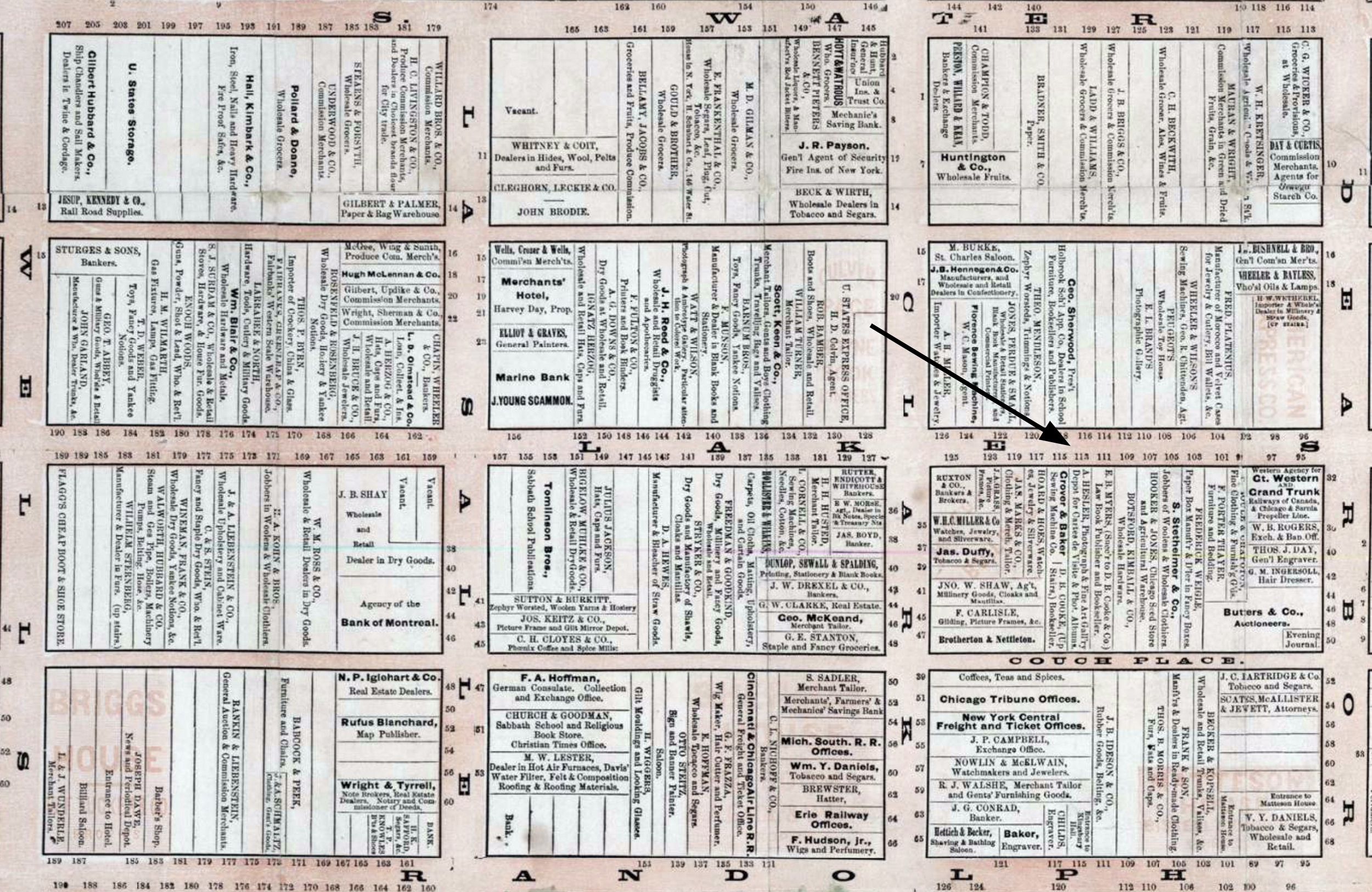
Hesler’s Studio
113 Lake Street
1862
NOTES:
1Excerpted from The Chicago Tribune, September 21, 1975.
2 Obviously this was an error by the editors. The photographs were taken in August, 1858.
Fascinating!